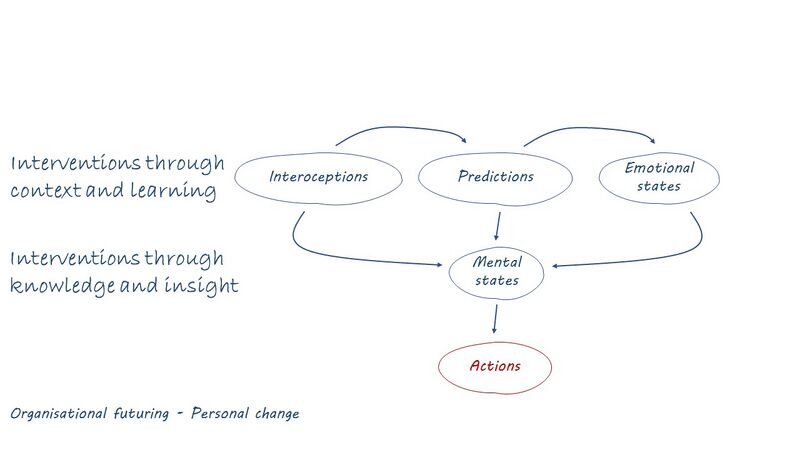Personal change
Back to Organisational futuring
Understanding Personal change
Mindset
| You can not change a mindset directly. Your mindset is the product of your experiences. What has worked, what hasn’t worked. The only way you change it, is you give people new experiences or you push them to do new thing that eventually change their minds. |
| Source |
|---|
| Herminia Ibarra - Charles Handy Professor of Organisational Behaviour at London Business School. - 2022 |
.
.
Context and learning over conscious change
The method in which one starts from the context in which someone finds himself is much more effective than trying to influence someone's 'personality'. Interoception, prediction and emotions are contextual precursors and much stronger than the mind.
--- The normal flow of reasoning is forward from what you believe to a possible consequence. When someone proposes a serious critical test, you cannot get from your theory to the result without adding an extra wrinkle to the theory. The extra wrinkle is hard to find—if it were easy, this would not be a serious critical test. On the other hand, the result probably follows from the adversary's theory. The lazy solution is to concede provisionally.
The situation changes completely when the result is known. It is a constraint and working backward to a slightly wrinkled theory is much easier. It's not the case that people refuse to admit that they had been wrong. From their perspective they were only wrong in failing to see that the experiment didn't prove anything.
When you ask people, why do you believe what you believe? They answer by giving reasons for their beliefs. Subjectively, we experience that reasons are prior to the beliefs that can be deduced from them. But we know that the power of reasons is an illusion. The belief will not change when the reasons are defeated. The causality is reversed. People believe the reasons because they believe in the conclusion.
"People don't change their minds."
—Daniel Kahneman
"Do not change minds, just open a little wider."
—Barb Mellers
| Source |
|---|
| Adversarial Collaboration: An EDGE Lecture by Daniel Kahneman - 2022 |
.
.
Habits
We all have habits we’d like to get rid of, and every night we give ourselves the same pep talk: I’ll go to bed earlier. I will resist that cookie. I will stop biting my nails. And then tomorrow comes, we cave, and feel worse than bad. We feel defeated and guilty because we know better and still can’t resist.
The cycle is understandable, because the brain doesn’t make changes easily. But breaking an unhealthy habit can be done. It takes intent, a little white-knuckling, and some effective behaviour modification techniques. But even before that, it helps to understand what’s happening in our brains, with our motivations, and with our self-talk.
We feel rewarded for certain habits
- Good are routines. Routines, like showering or driving to work, are automatic and make our lives easier. “The brain doesn’t have to think too much”.
- Bad habits are slightly different, but when we try to break a bad one we create dissonance, and the brain doesn’t like that. The limbic system in the brain activates the fight-flight-or-freeze responses, and our reaction is to avoid this“threat” and go back to the old behavior, even though we know it’s not good for us.
Often, habits that don’t benefit us still feel good, since the brain releases dopamine. It does this with anything that helps us as a species to survive, like eating or sex. Avoiding change qualifies as survival, and we get rewarded (albeit temporarily), so we keep reverting every time. “That’s why it’s so hard”.
Finding the reason why you want to change and the context how you can change
But before you try to change a habit, it’s fundamental to identify why you want to change. When the reason is more personal — you want to be around for your kids; you want to travel more — you have a stronger motivation and a reminder to refer back to during struggles.
After that, you want to figure out your internal and external triggers, and that takes some detectivework. When the bad habit urge hits, ask when, where, and with whom it happens, and how you arefeeling, be it sad, lonely, depressed, nervous. It’s a mixing and matching process and different for everyperson, but if you notice a clue beforehand, you might be able to catch yourself.
The next part — and sometimes the harder part — is modifying your behavior. If your weakness is a morning muffin on the way to work, the solution might be to change your route. But environments can’t always be altered, so you want to find a replacement, such as having almonds instead of candy or frozen yogurt in lieu of ice cream. “You don’t have to aim for perfect, but just a little bit healthier”.
| Source |
|---|
| How to break a bad habit - Harvard Gezette - 2022 |
